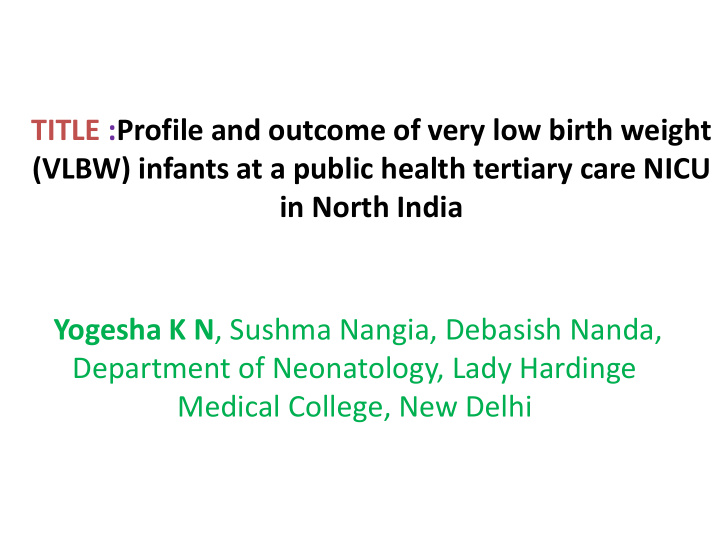



TITLE :Profile and outcome of very low birth weight (VLBW) infants at a public health tertiary care NICU in North India Yogesha K N , Sushma Nangia, Debasish Nanda, Department of Neonatology, Lady Hardinge Medical College, New Delhi
Background • In recent WHO report, approximately 2.9 million neonates die annually in the world. • Complications of prematurity is one the leading cause for neonatal death • About 15million premature births in the world and a million of children die each year due to complications of preterm birth WHO report 2014 Born Too Soon The Global Action Report on Preterm Birth 2012
Background • WHO defines Very low birth weight babies (VLBW) as birth weight < 1500 grams at birth irrespective of gestational age. • The incidence of VLBW babies is less than 2% of the births globally. • In India, VLBW babies constitute 4% to 7% of the live births and approximately 30% of neonatal death National Neonatal Perinatal Database Network. National Neonatology Forum of India; 2004. Eichenwald EC, Stark AR. N Engl J Med. 2008
Background Advances in neonatal care like, 1. Antenatal corticosteroids(ANS) 2. CPAP 3. Other modes of non invasive ventilation 4. Surfactant therapy 5. Gentle mechanical ventilation 6. Better understanding of disease process 7. Early enteral nutrition has resulted in improved survival of VLBW infants. Data related to survival and morbidity profile of VLBW infants is largely from high income countries. Similar data from LMICs is limited Eichenwald EC, Stark AR. N Engl J Med. 2008 S. Murki et al. Indian J Pediatr 2015
Objective To evaluate the clinical profile of VLBW infants from a tertiary care NICU of a public health Institution from North India
Study design Type of study : Prospective observational study Place of study : Nursery of Smt Sucheta Kriplani Hospital and Neonatal ward of Kalawati Saran Children’s Hospital & Lady Hardinge Medical College – a tertiary care centre with facility for ventilation and care of sick neonates. Duration of study : 24 months (Jan 2016 to Dec 2018) Study Subjects : All neonates with birth weight less than 1500gm.
Inclusion criteria All neonates of gestational age(GA) less than 1500gms will be enrolled Exclusion criteria • Major congenital malformation • Gestation less than 25 weeks • Refusal for consent
End point of the study The subject will be followed up to • Discharge from the hospital • Death
Results • Out of 25782 live births during the study period, 944 (3.7%) infants were VLBW and were admitted to the NICU. • Mean gestation age was 30+3 (24-39) weeks with 90% below 34 weeks and mean birth weight was 1157+327 (500-1498) gm .
Results • Overall(VLBW) survival was 84.2%, its in consistent with developed country study by Eric C. Eichenwald et al (survival is 84%) • Study from India showed, the neonatal mortality rate till discharge was 15.7% in VLBW group and 33.3% in ELBW group. • In S Murki et al study VLBW survival is 88%. • About 70.5% survival in south african study Roy KK. Indian J Pediatr. 2006 S. Murki et al. Indian J Pediatr 2015 Daynia E Ballot BMC Pediatrics2010
Results • Partial/complete course of antenatal corticosteroids was received by 68% mothers. • About a third of the infants had one or more antenatal risk factors for early onset sepsis. • Around 23% (213) required surfactant therapy with 76% receiving it by INSURE technique.
Baseline Characteristic s Baseline Characteristics Gestational age (Weeks) 30.7±2.89weeks (Mean±SD) ( 24.0-39.0) Birth weight (Grams) 1157+327 (500-1498) (Mean±SD) Male (%) 526(55.72%) Antenatal steroid (%) 636(68.0%) Cesarean delivery (%) 330(34.99%) Perinatal asphyxia (5 min 151(16.07%) APGAR ≤ 6) Duration of rupture of 331(35%) membrane >24 h
Survival according gestational 1.2 1 0.8 0.6 Survival(%) 0.4 0.2 0 ≤ 27 28-29 30-31 32-34 ≥35
Causes for mortality Sepsis IVH (grade ≥ 3) NEC Extreme prematurity
Outcomes Most common morbidity was sepsis (46.6%) followed by RDS (42%), it is consisted with many studies conducted in LMIC but RDS is most common morbidity in developed countries . Roy KK. Indian J Pediatr. 2006 S. Murki et al. Indian J Pediatr 2015 Daynia E Ballot BMC Pediatrics2010 Eichenwald EC . N Engl J Med. 2008
Outcomes Percentage Morbidity Number Sepsis 439 46.6% Meningitis 57 6.0% RDS 396 42% Air leak 12 1.3% HsPDA 49 5.2% IVH(any grade) 94 10% IVH ≥ grade 3 19 2.0% NEC ( any stage) 69 7.3% NEC stage ≥ 2 21 2.2% BPD 33 3.5% ROP 49 5.2%
Outcomes • Blood culture positivity was detected in 13.1% of sepsis cases • Klebsiella spp. being the commonest isolate (35%) followed by Staphylococcus aureus (20%), it is consisted with Indian data • Meningitis was diagnosed in 6% cases. National Neonatal Perinatal Database Network National Neonatology Forum of India; 2004
Outcomes • Ten percent developed any grade of IVH with 2% having severe IVH (IVH grade ≥ 3), • More than 2% (2.2%) developed NEC stage 2 or higher Any stage ROP was identified in nearly 5.2% • and 2.6% required treatment
Outcomes • Additionally, 5.2% had HsPDA requiring pharmacologic closure, 1.3% developed airleak • Three percent of the cases required oxygen(O 2 ) therapy beyond 28 days of life and only 1/4 th of these continued to require O 2 beyond 36 wks PMA
Thank You
Recommend
More recommend